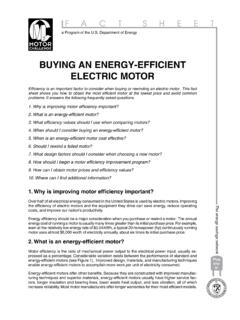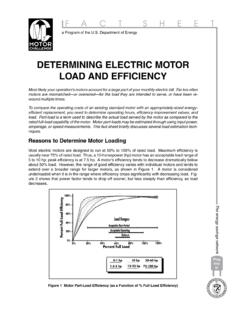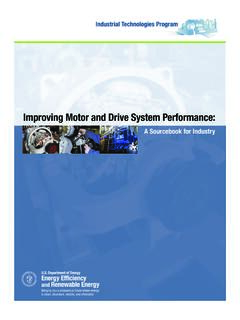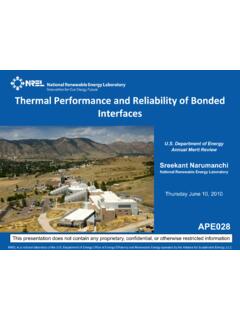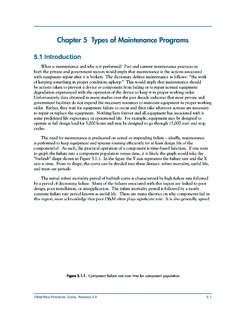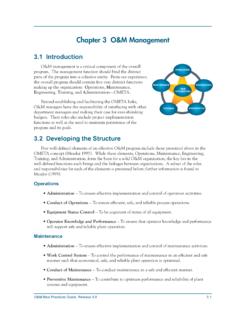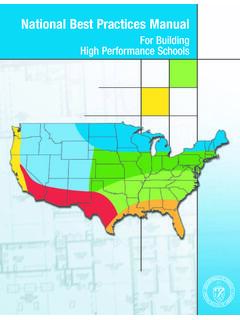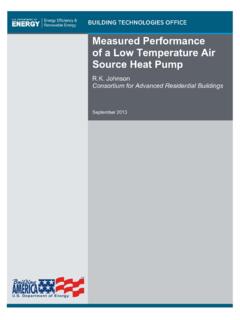Transcription of VARIABLE SPEED PUMPING - US Department of Energy
1 VARIABLE SPEED PUMPING . A GUIDE TO. SUCCESSFUL APPLICATIONS. EXECUTIVE SUMMARY. VARIABLE SPEED DRIVES. A WAY TO LOWER LIFE CYCLE COSTS. Department of Energy Energy Efficiency and Renewable Energy uropump Industrial Technologies Program Bringing you a prosperous future where Energy is clean, abundant, reliable, and affordable Table of Contents Introduction .. 1. PUMPING Systems .. 1. Selection Process New Systems .. 8. Selection Process Retrofitting to Existing Equipment .. 10. Benefits of VSDs .. 10. Potential Drawbacks of VSDs .. 10. Estimating PUMPING Energy Costs .. 12. Capital Cost Savings .. 13. Financial Justification .. 13. Example: VARIABLE SPEED Drives Fitted on a Primary Feed Pump and Product Transfer Pump in a Refinery .. 14. Acknowledgment VARIABLE SPEED PUMPING A Guide to Successful Applications, Executive Summary is the result of a collaboration between the Hydraulic Institute, Europump, and the Department of Energy 's (DOE) Industrial Technologies Program. Executive Summary Introduction PUMPING systems account for nearly 20% of the world's Energy used by electric motors and 25% to 50% of the total electrical Energy usage in certain industrial facilities.
2 Significant opportunities exist to reduce PUMPING system Energy con- sumption through smart design, retrofitting, and operating practices. In particu- lar, the many PUMPING applications with VARIABLE -duty requirements offer great potential for savings. The savings often go well beyond Energy , and may include improved performance, improved reliability, and reduced life cycle costs. Most existing systems requiring flow control make use of bypass lines, throttling valves, or pump SPEED adjustments. The most efficient of these is pump SPEED con- PUMPING applica- trol. When a pump's SPEED is reduced, less Energy is imparted to the fluid and less tions with VARIABLE - Energy needs to be throttled or bypassed. SPEED can be controlled in a number of duty requirements ways, with the most popular type of VARIABLE SPEED drive (VSD) being the VARIABLE offer great potential frequency drive (VFD). for Energy savings, improved perfor- Pump SPEED adjustment is not appropriate for all PUMPING systems, however.
3 This mance, and reduced overview provides highlights from VARIABLE SPEED PUMPING A Guide To Successful life cycle costs. Applications, which has been developed by Europump and the Hydraulic Institute as a primer and tool to assist plant owners and designers as well as pump, motor, and drive manufacturers and distributors. When the requirements of a pump and system are understood, the user can consult this guide to help determine whether VARIABLE SPEED PUMPING is the correct choice. The guide is applicable for both new and retrofit installations and contains flowcharts to assist in the selection process. PUMPING Systems A proper discussion of PUMPING considers not just the pump, but the entire pump- ing system and how the system components interact. The recommended systems approach to evaluation and analysis includes both the supply and demand sides of the system. PUMPING System Hydraulic Characteristics In a PUMPING system, the objective, in most cases, is either to transfer a liquid from a source to a required destination, , filling a high-level reservoir, or to circulate liquid around a system, , as a means of heat transfer.
4 Pressure is needed to The ratio of static make the liquid flow at the required rate and this must overcome losses in the sys- to friction head over tem. Losses are of two types: static and friction head. the operating range influences the ben- Static head, in its most simple form, is the difference in height of the supply and efits achievable destination of the liquid being moved, or the pressure in a vessel into which the from VSDs. pump is discharging, if it is independent of flow rate. Friction head (sometimes called dynamic head loss), is the friction loss on the liquid being moved, in pipes, valves, and other equipment in the system. This loss is proportional to the square of the flow rate. A closed-loop circulating system, without a surface open to atmo- spheric pressure, would exhibit only friction losses. 1. VARIABLE SPEED PUMPING A Guide To Successful Applications Most systems have a combination of static and friction head. The ratio of static to friction head over the operating range influences the benefits achievable from VSDs.
5 Static head is a characteristic of the specific installation. Reducing this head whenever possible generally reduces both the cost of the installation and the cost of PUMPING the liquid. Friction head losses must be minimized to reduce PUMPING cost, but after eliminating unnecessary pipe fittings and length, further reduction in friction head will require larger diameter pipes, which adds to installation cost. Pump Types Proper selection of pumps, motors, and controls to meet the process requirements is essential to ensure that a PUMPING system operates effectively, reliably, and effi- ciently. All pumps are divided into the two major categories of positive displace- ment (PD) and rotodynamic. PD pumps can be classified into two main groups: rotary and reciprocating. Rotary pumps typically work at pressures up to 25 Bar (360 pounds per square inch [psi]). These pumps transfer liquid from suction to discharge through the action of rotating screws, lobes, gears, rollers, etc.
6 , which operate within a rigid casing. Reciprocating pumps typically work at pressures up to 500 Bar. These pumps dis- charge liquid by changing the internal volume. Reciprocating pumps can gener- ally be classified as having a piston, plunger, or diaphragm, displacing a discrete volume of liquid between an inlet valve and a discharge valve. The rotary motion of the driver, such as an electric motor, is converted to the reciprocating motion by a crankshaft, camshaft, or swash-plate. The performance of a pump can be expressed graphically as head against flow rate. The rotodynamic pump has a curve where the head falls gradually with increasing flow. However, for a PD pump, the flow is almost constant whatever the head. It is customary to draw the curve for PD pumps with the axes reversed, but for comparison, a common presentation is used here for the two pump types. Head Head Flow Rate Flow Rate Figure ES-1. Figure ES-2. Performance curve for a Performance curve for a positive rotodynamic pump displacement pump 2.
7 Executive Summary Interaction of Pumps and Systems When a pump is installed in a system, the effect can be illustrated graphically by superimposing pump and system curves. The operating point will always be where the two curves intersect. PUMP CURVE. PUMP CURVE. OPERATING POINT. OPERATING POINT. Head Head SYSTEM CURVE. SYSTEM CURVE. Flow Rate Flow Rate Figure ES-3. Figure ES-4. System curve and a System curve and a perfor- performance curve for a mance curve for a positive rotodynamic pump displacement pump Many PUMPING systems For a PD pump, if the system resistance increases, , the system curve is moved require a VARIABLE flow or upwards, the pump will increase its discharge pressure and maintain a fairly con- pressure; VARIABLE SPEED stant flow rate, dependent on viscosity and pump type. Unsafe pressure levels reduces power dur- can occur without relief valves. For a rotodynamic pump, an increasing system ing periods of reduced resistance will reduce the flow, eventually to zero, but the maximum head is lim- demand.
8 Ited. Even so, this condition is only acceptable for a short period without causing problems. Adding comfort margins to the calculated system curve to ensure that a sufficiently large pump is selected will generally result in installing an oversized pump. The pump will operate at an excessive flow rate or will need to be throttled, leading to increased Energy use and reduced pump life. Many PUMPING systems require a variation of flow or pressure. Either the sys- tem curve or the pump curve must be changed to get a different operating point. Where a single pump has been installed for a range of duties, it will have been sized to meet the greatest output demand. It will therefore usually be oversized, and will be operating inefficiently for other duties. Consequently, there is an opportunity to achieve an Energy cost savings by using control methods, such as VARIABLE SPEED , which reduce the power to drive the pump during the periods of reduced demand. 3. VARIABLE SPEED PUMPING A Guide To Successful Applications Effects of SPEED Variation on Rotodynamic Pumps Varying the rotational A rotodynamic pump is a dynamic device with the head generated by a rotating SPEED has a direct impeller.
9 Thus, there is a relationship between impeller peripheral velocity and effect on the pump's generated head. Peripheral velocity is directly related to shaft rotational SPEED , performance. for a fixed impeller diameter. Varying the rotational SPEED therefore has a direct effect on the pump's performance. The equations relating rotodynamic pump per- formance parameters of flow to SPEED , and head and power absorbed to SPEED , are known as the Affinity Laws. Changing pump impeller diameter also effectively changes the duty point in a given system, and at low cost, but this can be used only for permanent adjustment to the pump curve and is not discussed further as a control method. For systems where friction loss predominates, reducing pump SPEED moves the intersection point on the system curve along a line of constant efficiency (see Figure ES-5). The operating point of the pump, relative to its best efficiency point, remains constant and the pump continues to operate in its ideal region.
10 The Affinity Laws are obeyed, which means that there is a substantial reduction in power absorbed accompanying the reduction in flow and head, making VARIABLE SPEED the ideal control method. 80. 70. 1480 r/min Iso-Efficiency Lines 60 h = 71%. 1350 r/min h = 83% System Curve Total Head m 50 h = 86%. Power kW. Figure ES-5. Example of the effect 1184 r/min h = 83%. 40. of pump SPEED change in a system with only 30 150. Operating Points friction loss 1480 r/min 100. 1350 r/min 1184 r/min 50. 0. 0 200 400 600 800 1000 1200. Rate of Flow m3/h m: meter m3/h: cubic meters per hour kW: kilowatt r/min: revolutions per minute 4. Executive Summary However, in systems with high static head, the system curve does not start from the origin but at some non-zero value on the y-axis corresponding to the static head. Hence, the system curve does not follow the curves of constant efficiency. Instead, it intersects them (see Figure ES-6). The reduction in flow is no longer proportional to SPEED ; a small turn down in SPEED greatly reduces flow rate and pump efficiency.
